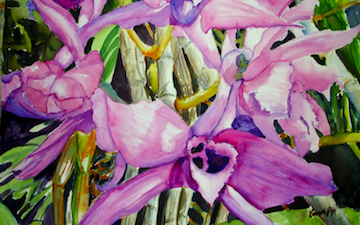Dendrobium is a huge genus of orchids. It was established by Olof Swartz in 1799 and today contains about 1,200 species. The genus occurs in diverse habitats throughout much of south, east and southeast Asia, including the Philippines, Borneo, Australia, New Guinea, Solomon Islands and New Zealand. The name is from the Greek dendron (“tree”) and bios (“life”); it means “one who lives on trees”, or, essentially, “epiphyte“.
Dendrobium species are either epiphytic [grow on trees], or occasionally lithophytic [grow on rocks]. They have adapted to a wide variety of habitats, from the high altitudes in the Himalayan mountains to lowland tropical forests and even to the dry climate of the Australian desert.
(From Wikipedia, 5 May 2011)
Dendrobium orchids are found throughout the western Pacific and east Asia from as far north as Japan to as far south as Tasmania and southern New Zealand, east to Tahiti and west to western India (Lavarack et al. 2000). The genus (as currently delineated) includes more than a thousand species found in widely varying habitats (Lavarack et al. 2000; Adams et al. 2006). Like most other epiphytes, Dendrobium orchids are restricted to areas of moderate to high rainfall (e.g., in tropical lowlands, annual rainfall of more than 150 cm and a dry season of less than 6 months; at higher elevations in the tropics, or in cooler temperate regions, drier conditions can be tolerated).
Dendrobium orchids vary in size from tiny creeping plants less than a centimeter high (e.g., D. toressae) to clumped bamboo-like plants several meters tall (e.g., D. discolor). Although most are epiphytes, some grow on rocks or on the ground. All Dendrobium (even the terrestrial species) have coarse, spreading root systems, unlike the tuberous root systems characteristic of terrestrial orchids from temperate regions. (Lavarack et al. 2000)
Perhaps a third of the 30,000 or so orchid species are deceptive, attracting pollinators but then failing to reward them with pollen or nectar. Many of these orchids imitate the scent of rewarding flowers or potential mates. However, one rewardless Dendrobium orchid, Dendrobium sinense, is pollinated by the hornet Vespa bicolor, which it apparently attracts by mimicking the alarm pheromone produced by honeybees, which hornets frequently hunt as food for their larvae (Brodmann et al. 2009).
(From EOL, 6 May 2011)





